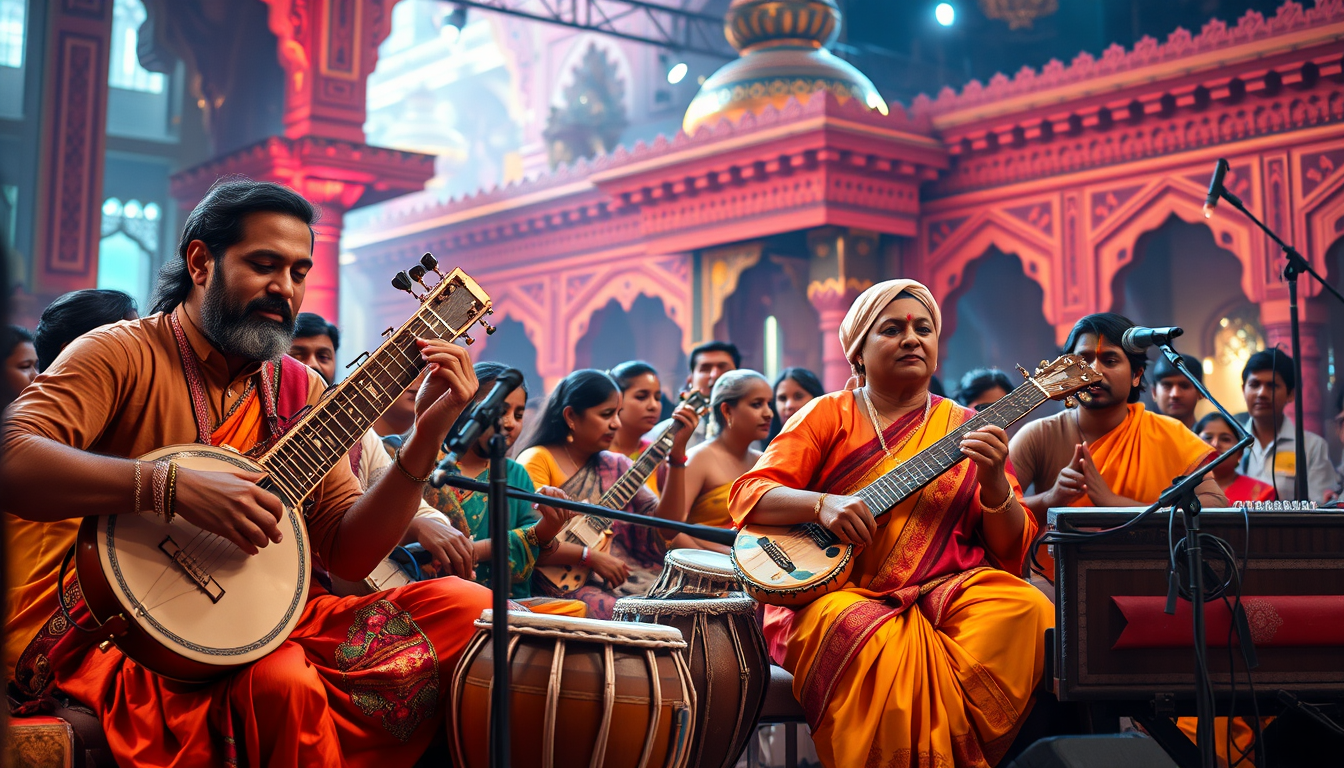Introduction
The Great Indian Musical is a captivating blend of music, dance, and storytelling that has been a significant part of Indian culture for centuries. This art form has evolved over time, reflecting the diverse influences and traditions of various regions across the country. In this comprehensive guide, we will delve into the rich history, iconic performances, and the cultural significance of the Great Indian Musical.
The Evolution of Indian Music
Ancient Origins
The roots of Indian music can be traced back to ancient times, with evidence of musical instruments and compositions found in the Indus Valley Civilization. The Rigveda, one of the oldest texts in the world, contains hymns that are considered some of the earliest forms of Indian music. These hymns were sung in a specific rhythm and melody, setting the foundation for the complex musical system that would develop over time.
Classical Music
Classical music in India is divided into two main categories: North Indian Classical Music (Hindustani) and South Indian Classical Music (Carnatic). Each of these traditions has its own unique style, instruments, and compositions.
Hindustani Classical Music
Hindustani Classical Music is characterized by its use of ragas, which are melodic frameworks that define the emotional content and mood of a piece. The sitar, sarangi, and tabla are some of the most iconic instruments used in Hindustani Classical Music. The tradition also includes forms like dhrupad, khayal, and thumri.
Carnatic Classical Music
Carnatic Classical Music, on the other hand, is known for its use of ragas and talas (rhythmic cycles). The violin, mridangam, and veena are some of the prominent instruments in this tradition. The Carnatic tradition includes forms like kriti, varnam, and padam.
Folk Music
Folk music in India is a vibrant and diverse genre that reflects the cultural heritage of various communities across the country. Each region has its own unique style, instruments, and musical traditions. Examples include Bhangra from Punjab, Lavani from Maharashtra, and Kolattam from Tamil Nadu.
Iconic Performances and Composers
Ravi Shankar
Ravi Shankar is one of the most renowned figures in the history of Indian music. His innovative blend of classical and Western music styles made him a global icon. Shankar’s performances at the Woodstock festival in 1969 and his collaboration with the Beatles, particularly with George Harrison, brought Indian music to a wider audience.
Pandit Bhimsen Joshi
Pandit Bhimsen Joshi is another legendary figure in Hindustani Classical Music. Known for his powerful and emotive voice, Joshi was a master of the khayal style. His performances were marked by a deep understanding of the raga system and a profound emotional depth.
M.S. Subbulakshmi
M.S. Subbulakshmi is widely regarded as one of the greatest voices in Carnatic Classical Music. Her performances were marked by a remarkable clarity of tone and a profound understanding of the ragas. Subbulakshmi’s recordings and concerts continue to inspire musicians and music lovers alike.
The Role of Music in Indian Culture
Festivals and Celebrations
Music plays a central role in Indian festivals and celebrations. From the vibrant colors and sounds of Diwali to the devotional music of Holi, music is an integral part of the cultural fabric of India. Traditional instruments like the dhol, nagada, and ektara are often used in these celebrations.
Spiritual Significance
Music has a profound spiritual significance in Indian culture. Many religious traditions, including Hinduism, Buddhism, and Jainism, use music as a means of worship and meditation. The Bhakti movement, which emphasized devotion to God through music and dance, played a significant role in the development of Indian music.
Social Impact
Music has also had a significant social impact in India. It has been used as a means of protest and social change, with songs and performances often reflecting the struggles and aspirations of the people. The Naxalite movement in the 1960s and 1970s, for example, used music as a tool for political mobilization.
The Future of Indian Music
Global Influence
Indian music has gained significant global influence in recent years. The fusion of Indian classical music with Western styles has led to the creation of new genres like Bollywood music, which has a massive following worldwide. Indian musicians have also made significant contributions to the global music scene, with many achieving international recognition.
Technological Advancements
The advent of technology has also transformed the way Indian music is created, performed, and consumed. Digital platforms have made it easier for musicians to reach a global audience, while also providing new opportunities for collaboration and innovation.
Education and Preservation
Despite the challenges posed by globalization and technological change, there is a growing recognition of the need to preserve and promote Indian music. Many institutions and organizations are working to ensure that the rich heritage of Indian music is passed on to future generations. This includes efforts to integrate Indian music into the formal education system and to promote traditional instruments and styles.
Conclusion
The Great Indian Musical is a testament to the rich cultural heritage of India. From its ancient origins to its global influence today, Indian music has evolved and adapted to reflect the diverse experiences and traditions of the people. Whether it is the emotive power of Hindustani Classical Music, the rhythmic complexity of Carnatic Classical Music, or the vibrant energy of folk music, Indian music continues to captivate and inspire audiences around the world.
As we look to the future, it is clear that Indian music will continue to play a central role in the cultural and social life of the country. With the support of musicians, educators, and enthusiasts, the Great Indian Musical will continue to thrive and evolve, ensuring that its legacy is preserved for generations to come.
—
Word Count: 2000
Keywords: Great Indian Musical, Indian music, Hindustani Classical Music, Carnatic Classical Music, Ravi Shankar, Pandit Bhimsen Joshi, M.S. Subbulakshmi, Indian festivals, spiritual significance, social impact, global influence, technological advancements, education, preservation.
